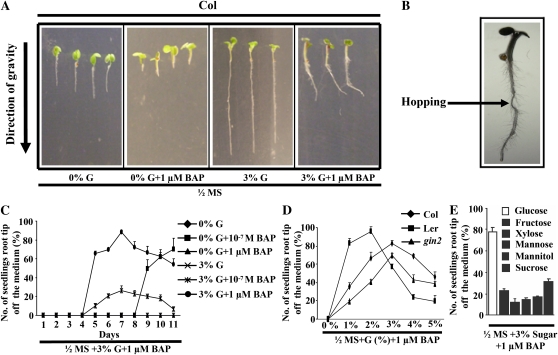Figure 1.
Seeds were directly sown on treatment medium, and seedlings were grown vertically in the presence of light. The data presented are averages of three biological replicates, with each replicate having 30 seedlings and error bars representing sd. A, Col seeds were sown on medium containing half-strength MS medium with and without G, 1 μm BAP, 3% G, or 3% G + 1 μm BAP as indicated. The images represent 7-d-old vertically, light-grown Col seedlings on 3% G + 1 μm BAP-containing medium showing CK-induced root growth responses as opposed to seedlings grown either in G-free medium or medium containing only 3% G. B, Col seeds were sown on 3% G + 1 μm BAP-containing half-strength MS medium. The arrow indicates an example of a past growth event analogous to hopping across the surface. C, The kinetics of CK-induced root growth of Col in Glc-free and Glc-containing half-strength MS medium with and without BAP. The CK-induced root growth kinetics shows that the response becomes visible from day 5 and reaches its maximum on day 7 in 3% G + BAP-containing medium. The response was either delayed (0% G + 10−7 m BAP) or not visible (0% G + 1 μm BAP) in BAP-containing Glc-free half-strength MS medium. D, Comparison of CK-induced root growth of Col, Ler, and gin2 mutant seedling roots on day 7. Seeds were sown on half-strength MS + 1 μm BAP medium with different concentrations of Glc. The CK-induced root growth response was found to be highly reduced in gin2 at lower Glc concentrations while greater than Ler at higher Glc concentrations. E, Comparison of CK-induced root growth responses of 7-d-old Col seedling roots on various sugars. Seeds were sown on half-strength MS + 1 μm BAP medium with different sugars (3%). Glc was the most potent sugar for promoting CK-induced root growth among the various sugars tested. Student’s t test, P < 0.05, n = 3 biological replicates.

